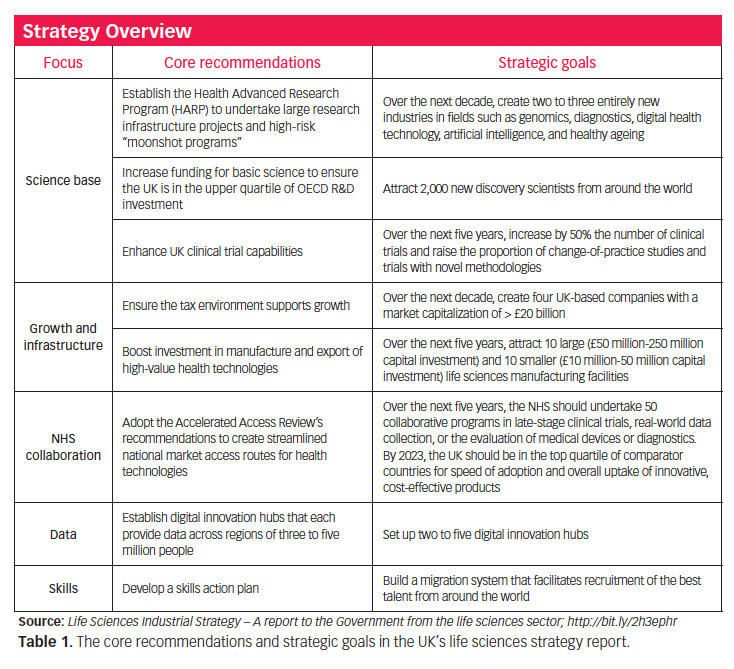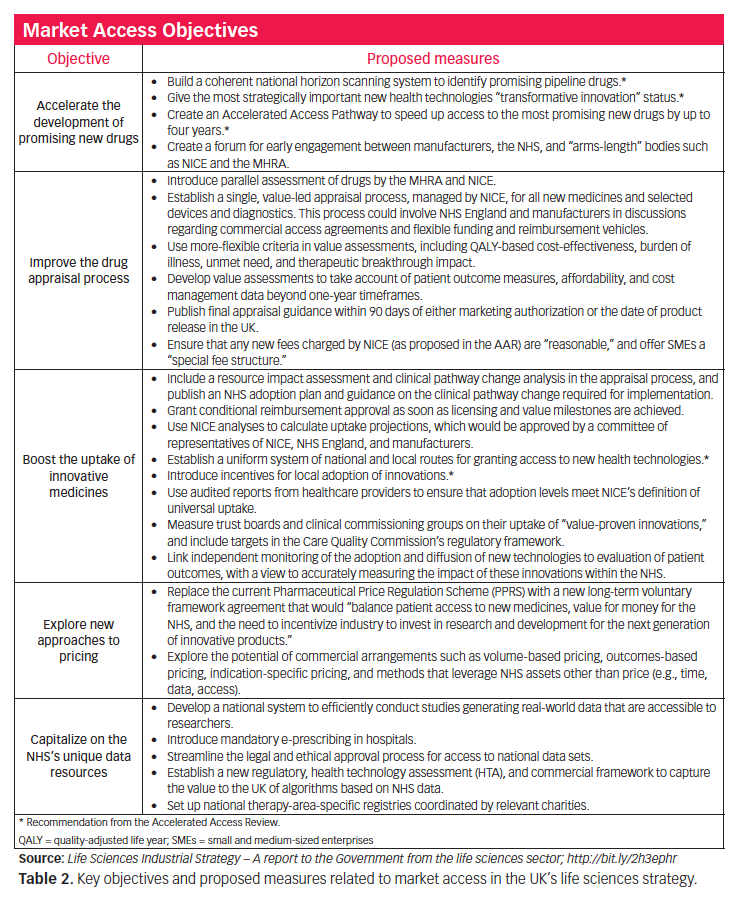Interpreting UK’s Post-Brexit Life Sciences Strategy
Pharmaceutical Executive
A deep dive into the outlook and implications from the UK’s recently unveiled life sciences blueprint for a post-Brexit world.
The eagerly awaited life sciences strategy commissioned by the UK government avowedly “places an emphasis on putting the UK in a world-leading position to take advantage of the health technology trends of the next 20 years.” The report, prepared by eminent geneticist Prof. Sir John Bell, and released in August, is the product of consultation with a range of stakeholders, including the National Health Service (NHS), the Association of the British Pharmaceutical Industry (ABPI), the BioIndustry Association (BIA), the devolved administrations in Scotland, Wales, and Northern Ireland, a range of manufacturers, and charities.
Five key themes
The strategy covers five broad themes: the UK’s science base, growth and infrastructure, collaboration between the NHS and industry, the digitalization of healthcare, and ensuring access to the skills needed to support a flourishing life sciences industry. Table 1 (click to enlarge) summarizes the core recommendations and strategic goals in each of these five areas.

Regulation
Curiously, regulation is not one of the key themes of the life sciences strategy. Nevertheless, the report does include a short section devoted to this subject, with a focus on the implications of Brexit for the future regulatory environment in the UK.
The strategy notes that, “given the UK market size at around 3% of global pharmaceutical sales, a wholly free-standing system would likely be high cost-both in terms of efficiency and attractiveness to companies who typically apply to the largest markets first. Industry’s view is that the UK and the MHRA (Medicines and Healthcare Products Regulatory Agency) should therefore seek to continue to work closely with the EMA (European Medicines Agency) to deliver the best regulatory service for patients across the EU and UK.” The report recommends different approaches for the various elements of regulation:
- For clinical trials, pharmacovigilance, and other activities in which larger patient populations improve the quality of evidence for decision-making, the UK and the EU should pursue continued collaboration. The UK should also seek continued participation in mutual recognition agreements, such as the FDA/EMA agreement with regard to manufacturing inspections.
- For pharmaceutical licensing, continued participation of the MHRA in the EMA’s dossier reviews and joint scientific deliberations would be beneficial to patients in both the UK and EU. If the UK did not wish to be involved in the EU voting system, it could make its own “sovereign decision” based on the shared information and deliberations.
- For medical devices, it would be advantageous for the UK to continue to use the CE marking system, which applies not just in the EU, but also in Israel, Norway, and Turkey.
The strategy is cautious about talk of the UK pioneering an innovative regulatory approach to emerging technologies, such as cell and gene therapies, algorithms, and digital medicines. Within the current EU regulatory system, the MHRA has been a leading advocate of reform (e.g., adaptive licensing), but a post-Brexit

UK would need to ensure that any pursuit of new approaches to regulation did not jeopardize its involvement in EU systems and processes.
The report does identify a couple of areas of regulation in which the UK might usefully distance itself from practice in the EU. The strategy recommends that the UK continue its relatively liberal approach to the regulation of stem cell research. The General Data Protection Regulation (GDPR), due to be implemented in May 2018, will make data sharing more onerous in the EU. The strategy recommends that, following Brexit, the UK should “attempt to maintain the current balanced approach to data sharing regulations,” with a view to creating an integrated digital environment that will attract manufacturers and benefit patients. However, even companies that are based outside the EU but provide goods or services to individuals in the EU, or monitor their behavior, will be required to comply with the terms of the GDPR.
Market access
Although the strategy document term does not explicitly mention “market access,” it does contain numerous proposals related to this subject. The report asserts that “the country’s strength in clinical trials puts it in an enviable position, but the UK commercial environment needs improving, with the NHS working more effectively with industry. To assure the future of the UK life sciences sector, it is necessary to improve the relationship between the healthcare system and industry, and for these partners to work more coherently together to deliver better patient outcomes and create economic growth.”
The life sciences strategy broadly supports the adoption of the Accelerated Access Review (AAR), published in October 2016, which the UK government commissioned to find ways to make innovative health technologies available to patients sooner. However, the report also proposes numerous market access measures that go beyond the AAR’s recommendations. Table 2 (click to enlarge) provides an overview of the strategy’s proposals in relation to market access.

Accelerating new drug development
The life sciences strategy endorses the AAR’s call for a more-coherent national horizon scanning system and the creation of an Accelerated Access Pathway to speed up access to the most promising new drugs by up to four years. However, only five to 10 technologies-not just drugs, but also diagnostics, medical devices, and digital products-are expected to be granted transformative innovation status each year. Furthermore, not all of these technologies would necessarily complete the Accelerated Access Pathway-some might drop out at various points along the way. In addition, the pharmaceutical industry will be skeptical of the benefit of transformative innovation status without a commitment to additional funding for these privileged products.
Drug manufacturers would welcome a forum for early engagement with the NHS, the National Institute for Health and Care Excellence (NICE), and the MHRA, provided that stakeholders uphold the conclusions reached in these discussions, and do not subsequently change their minds without good cause-a recurring criticism made by pharma companies of early dialogue elsewhere.
Improving the drug appraisal process
Parallel assessment of drugs by the MHRA and NICE, and the proposed requirement to publish final appraisal guidance within 90 days of either marketing authorization or the date of product release in the UK, could significantly expedite NHS reimbursement of new medicines. However, such a reform would require NICE to radically alter its working methods and be prepared to accept possible data limitations at launch.
The recommendation that NICE appraise all new medicines, as well as selected devices and diagnostics, would increase the institute’s workload, and presumably require an expansion of its capacity.
The pharma industry would support the suggested use of more-flexible criteria in value assessments. Similarly, drug manufacturers would welcome a longer-term perspective in value assessment.
Boosting the uptake of innovative medicines
One of the life sciences industry’s greatest frustrations with the UK pharmaceutical market is its relatively slow uptake of new medicines. The life sciences strategy seeks to tackle this problem through a range of policies to assess the potential impact on the NHS of new therapies, provide guidance on the adaptation of clinical pathways, incentivize uptake, and measure adoption. Granting a new medicine conditional reimbursement approval as soon as it achieves specified licensing and value milestones would also expedite uptake. Linking the monitoring of adoption and diffusion of new technologies to evaluation of patient outcomes would similarly give payers and providers reassurance that the impact of these innovations on the NHS will be accurately measured, presumably with a view to refining policy based on the evidence gathered.
All of these measures will likely be necessary if the NHS is to achieve the strategic goal that the UK should rank in the top quartile of comparator countries for speed of adoption and overall uptake of innovative, cost-effective products by 2023.
Exploring new approaches to pricing
The current Pharmaceutical Price Regulation Scheme (PPRS) is due to expire at the end of 2018. The strategy document does not mention the PPRS explicitly, but it does report that the life sciences industry favors replacing the existing arrangements for drug pricing with a new long-term voluntary framework agreement by the beginning of 2019. The industry would like a new system to “balance patient access to new medicines, value for money for the NHS, and the need to incentivize industry to invest in research and development for the next generation of innovative products.”
In addition, the life sciences strategy echoes the AAR in identifying a future role for a variety of commercial arrangements, including volume-based pricing, outcomes-based pricing, indication-specific pricing, and methods that leverage NHS assets other than price (e.g., time, data, access). Such arrangements would be the exception, reserved for products that are expected to have a significant impact on the NHS budget.
Capitalizing on the NHS’s unique data resources
According to the life sciences strategy, “one of the most important resources held by the UK health system is the data generated by the 65 million people covered within it.” Developing platforms to facilitate the use of anonymized patient data in the R&D of new health technologies could potentially help manufacturers, improve the quality of care for patients, and-importantly-save the NHS money. The strategy document suggests that “the ability to demonstrate the true value of products on an ongoing basis should allow a reduction in the cost and time to bring new treatments to patients, with the same data enabling healthcare systems to procure more effectively by, for example, rewarding outcomes or targeting treatments to those groups where they will work best.”
The report sees a need to establish a new regulatory, health technology assessment (HTA), and commercial framework “to capture for the UK the value in algorithms generated using NHS data.” This statement refers primarily to opportunities to apply lessons learned in local initiatives at a national level, thereby disseminating best practice. However, the strategy document may also be alluding to opportunities for the UK to use the value of algorithms based on NHS data as a bargaining chip when negotiating prices with manufacturers; the inference is that companies could apply what they learn in the UK to other comparable markets.
The call for the creation of national therapy-area-specific registries is interesting. Over the past decade, Italy has pioneered the development of a national network of Web-based registries, which underpin that country’s extensive managed entry program. Given that both the AAR and the life sciences strategy advocate an expansion of managed entry agreements in the UK, a new network of registries would presumably play an important role in that process.
Outlook, implications for pharma industry
Historically, the UK has been a major player in the EU regulatory environment, not least as the home of the EMA and one of the most active national agencies in centralized and decentralized approval procedures. However, with the EMA set to leave London as a consequence of Brexit, there will inevitably be a decline in UK influence, not just in decision making on individual drugs, but also shaping the overall approach to pharmaceutical regulation in Europe.
The life sciences strategy seeks to minimize the regulatory impact of Brexit by advocating continued collaboration between the MHRA and the EMA. Given the relatively small size of the UK market in global terms, continued alignment with the EU regulatory system would likely help to reduce the risk that manufacturers will delay launching new medicines in the UK. However, even if the UK government accepts the strategy’s recommendations in this area, it remains to be seen if the EU will be happy for the UK to continue to play an active role in its regulatory system.
The strategy’s broad endorsement of the AAR is good news for the handful of health technologies that will be fortunate to qualify for “transformative innovation” status, but it could impose unwelcome new burdens on a wider range of technologies (e.g., disinvestment in products and procedures that are deemed to be outdated or not cost-effective, new NICE fees, a budget impact threshold of £20 million [$26.5 million]).
The industry must also be concerned that the government has yet to formally respond to, let alone begin implementing, the AAR-more than 10 months (as of this writing) after its publication. Companies certainly hope the government will be quicker to act on the life sciences strategy’s recommendations. However, the strategy presents the danger of a paradox: it is intended to bolster the UK’s success in life sciences in a post-Brexit world, yet the government’s preoccupation with negotiating-and then implementing-Brexit may limit its capacity to embrace the radical change proposed in the strategy.
Drug manufacturers would generally support the strategy’s proposed changes to the HTA process, especially much earlier publication of appraisals, greater flexibility in the choice of appraisal criteria, and a longer-term perspective on the assessment of value.
Measures to boost the uptake of innovative medicines would be even more beneficial to drug manufacturers. The pharma industry has long been frustrated that NHS decision-makers have been quick to implement negative appraisals from NICE, but much slower to adopt positive recommendations (despite a statutory obligation to do so within 90 days of publication of a judgment). Manufacturers have also been highly critical of pronounced geographic variations in the uptake of new medicines-the so-called “postcode lottery.”
The life sciences strategy’s proposals for providing guidance on the adaptation of clinical pathways, incentivizing uptake, and measuring adoption should help to increase the use of novel health technologies in the UK. Nevertheless, the strategic goal for the UK to rank in the top quartile of comparator countries for speed of adoption and overall uptake of innovative, cost-effective products by 2023 may be somewhat ambitious.
The industry’s call for a new pricing system to replace the PPRS from 2019 onward is not surprising. The life sciences strategy’s recommendation that a new system should “balance patient access to new medicines, value for money for the NHS, and the need to incentivize industry to invest in research and development for the next generation of innovative products” would keep all stakeholders happy, but it is somewhat vague as a blueprint for reform.
The proposal that the NHS should explore a wider variety of commercial arrangements for products that are expected to have a significant budget impact is interesting. To date, the overwhelming majority of patient access schemes in the UK have been simple discounts-a reflection of the resistance to the administrative cost and burden associated with more-complex types of managed entry agreement. The suggested creation of a network of national registries could play a significant role in a future shift toward performance-based agreements.
The life sciences strategy certainly identifies the NHS’s unique data resources as a very significant asset in terms of attracting pharma companies to the UK market and strengthening the healthcare system’s hand in negotiating with manufacturers. The report also appears to imply that manufacturers might be expected to offer the UK more-favorable pricing in return for access to NHS data that they could apply to launches in other markets.
A key question that is not thoroughly addressed by the life sciences strategy is how its recommendations will apply to all the countries that make up the UK Although the UK is extremely proud of its National Health Service-to the point of featuring it prominently in the opening ceremony of the 2012 Olympic Games-it is now more accurate to speak of four National Health Services, given that responsibility for healthcare is devolved to each of the constituent nations of the UK.
The life sciences strategy describes itself as a “framework for the improvement of the life sciences sector for the whole of UK,” but it is written from the perspective of England, which accounts for 84% of the UK population.

It is unclear how references to essentially English institutions such as NICE, NHS England, the Care Quality Commission, and clinical commissioning groups will be adapted to the three other home countries.
One of the greatest obstacles to wholesale implementation of the life sciences strategy is likely to be funding. The report suggests that, “if the NHS is to be a partner of the life sciences sector, then it is appropriate that economic gains made through the life sciences strategy and the resulting efficiency benefits in the NHS should be recognized and directly used to support additional government investment back into the sector. This would create a virtuous cycle whereby the success of the UK’s life sciences sector yields sustainable, increased investment in medicines and technologies which benefit patients.”
At the publication of the life sciences strategy, the government announced £160 million ($207 million) of funding for new initiatives: £146 million ($189 million) for five major projects in the field of advanced therapies, advanced medicines, and vaccines development and manufacturing, and a further £14 million ($18 million) for 11 medical technology research centers to promote collaboration between the NHS and industry. It remains to be seen if the government will be willing to commit the resources required to implement the report’s full range of proposals.
Real action awaits
The life sciences strategy undoubtedly presents some exciting new opportunities for collaboration between the NHS and industry, but the report arguably raises at least as many questions as it answers. The strategy document states that it “should start the conversation between industry and government as to what both parties can invest, in order to achieve the ambitious vision set out and reap the benefits in the UK of improved health and a strong economy.” The most crucial question of all will be whether industry and government can agree on how to implement the life sciences strategy’s key recommendations as a matter of urgency.

Neil Grubert is a global market access consultant based in the UK

Addressing Disparities in Psoriasis Trials: Takeda's Strategies for Inclusivity in Clinical Research
April 14th 2025LaShell Robinson, Head of Global Feasibility and Trial Equity at Takeda, speaks about the company's strategies to engage patients in underrepresented populations in its phase III psoriasis trials.
Beyond the Prescription: Pharma's Role in Digital Health Conversations
April 1st 2025Join us for an insightful conversation with Jennifer Harakal, Head of Regulatory Affairs at Canopy Life Sciences, as we unpack the evolving intersection of social media and healthcare decisions. Discover how pharmaceutical companies can navigate regulatory challenges while meaningfully engaging with consumers in digital spaces. Jennifer shares expert strategies for responsible marketing, working with influencers, and creating educational content that bridges the gap between patients and healthcare providers. A must-listen for pharma marketers looking to build trust and compliance in today's social media landscape.